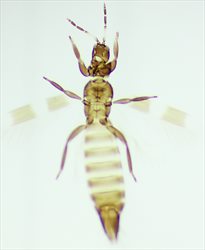
Female
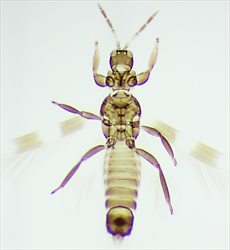
Male
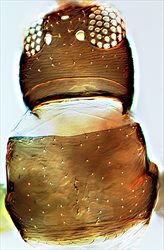
Head & pronotum
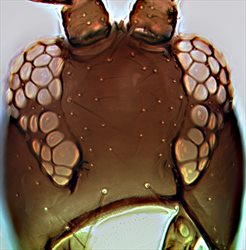
Head ventral view
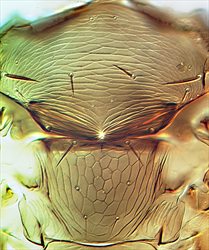
Meso & metanota
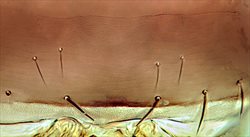
Female sternite VII
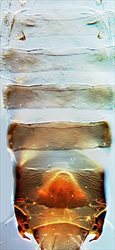
Male abdominal tergites
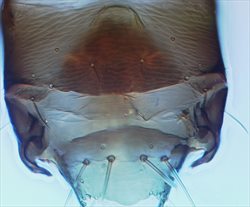
Male tergite IX
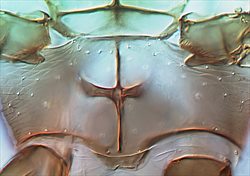
Male mid-coxae & metasternum
Both sexes fully winged. Female with fore wings bearing two transverse dark bands, apical ring vein not darker than the membrane it surrounds. Body, legs and antennae brown, but antennal segment III paler than II. Antennae 9-segmented, segment III with linear sensorium no more than half as long as segment, IV with sensorium a little more than half as long as segment; segments V–IX forming a single unit with V considerably longer than VI–IX. Head and pronotum with no long setae. Fore tarsus apically with stout recurved ventral hamus. Metanotum reticulate. Marginal setae on sternites arising at or close to margin; distance between median marginal pair on VII more than 2.0 times their length; paired accessory setae on VII arising further from the margin than their length.
Male fore wings similar to those of female; tergites IV–V each with pair of tubercles, IX with paired bifurcate claspers, but without paired sickle-shaped setae; mid-coxae inner posterior margin ventrally with series of ridges and prominent tubercle.
Over 100 species are placed in the genus Aeolothrips, mostly from the Palaearctic Region but with about 30 from the Nearctic including western USA. A. intermedius is a member of the Eurasian species-complex that includes A. ericae and A. fasciatus Linnaeus. The females are particularly similar to those of ericae except in colour, but the males lack stout anterolateral setae on the ninth abdominal tergite. Sometimes, A. intermedius has been misidentified as fasciatus, a Central European species of which there seems to be no valid record from Britain. Females of fasciatus have antennal segment III with a very narrow brown apical band, and males of fasciatus have a pair of long posteroangular setae on tergite IX that extend beyond the apex of the claspers.
Associated with the flowers of various plants in the families Asteraceae, Cruciferae, and Fabaceae, often in yellow flowers. This species is a facultative predator, feeding on a mixed diet of pollen and the larvae of other thrips in the flowers where it breeds (Bournier et al., 1979).
Particularly common in southern Britain, but also recorded as far north as Aberdeen (Mound et al., 1976). The species is widespread across Europe (zur Strassen, 2003) to the Asian Palaearctic and also south to Iran (Alavi & Minaei, 2018), but it is often confused with Aeolothrips fasciatus. In the past, the name fasciatus has been wrongly applied to specimens of intermedius from Britain (Collins, 2010a).
AEOLOTHRIPIDAE
Aeolothrips intermedius Bagnall
Aeolothrips fasciata var. adusta Uzel, 1895: 73
Aeolothrips fasciata var. aptera Karny, 1910: 44
Aeolothrips intermedius Bagnall, 1934: 123
Aeolothrips pontica Derbeneva, 1966: 136
Alavi J & Minaei K. (2018) Studies on the genus Aeolothrips (Thysanoptera: Aeolothripidae) in Iran, with a key to species. Zootaxa 4446 (3): 343–360.
Bournier A, Lacasa A. & Pivot Y (1979) Régime alimentaire d'un thrips prédateur, Aeolothrips intermedius (Thys.: Aeolothripidae). Entomophaga 24: 353–361.
Collins DW (2010a) Thysanoptera of Great Britain: a revised and updated checklist. Zootaxa 2412: 21–41.
Mound LA, Morison GD, Pitkin BR & Palmer JM (1976) Thysanoptera. Handbooks for the Identification of British Insects 1 (11): 1–79.
zur Strassen R (2003) Die terebranten Thysanopteren Europas und des Mittelmeer-Gebietes. Die Tierwelt Deutschlands 74: 1–271.